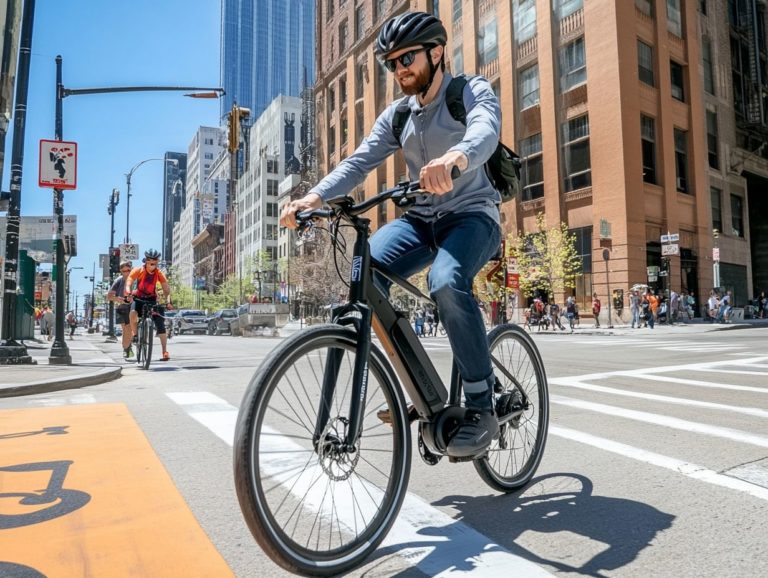Top 5 Electric Bicycle Laws Every Rider Should Know
Electric bicycles are revolutionizing your daily commute, blending convenience, eco-friendliness, and sheer enjoyment into one ride.
As their popularity surges, you must grasp the rules and regulations for using these innovative machines. Get ready to discover the essential laws every electric bike rider should know, including age restrictions, speed limits, and necessary safety equipment.
You will also learn the differences between electric bicycles and traditional motorized vehicles, navigate the registration process, understand insurance requirements, and pick up valuable tips for safe riding.
By the time you finish reading, you will be equipped with the knowledge to ride responsibly and have a blast while doing it.
Contents
- Key Takeaways:
- Understanding Electric Bicycle Laws
- Age Restrictions for Riding an Electric Bicycle
- 3. Speed Limits for Electric Bicycles
- 4. Required Equipment for Electric Bicycles
- 5. Where Electric Bicycles Can Be Ridden
- 6. Differences Between Electric Bicycles and Motorized Vehicles
- 7. How to Register an Electric Bicycle
- 8. Insurance Requirements for Electric Bicycles
- 9. Penalties for Violating Electric Bicycle Laws
- 10. How to Stay Safe While Riding an Electric Bicycle
- What Are the Benefits of Using an Electric Bicycle?
- Frequently Asked Questions
Key Takeaways:

- Know the rules to ride safely and avoid fines.
- Ensure you meet the age restrictions for riding, as they may differ from traditional bicycles.
- Be aware of speed limits for electric bicycles to keep yourself and others safe.
Understanding Electric Bicycle Laws
The rules governing electric bicycles, commonly known as e-bikes, vary significantly across different jurisdictions. This creates a complex legal landscape that you must navigate as both a consumer and a manufacturer. You must understand federal guidelines and state laws from places like California, Massachusetts, and New York to ensure compliance with the consumer product safety standards set by the Consumer Product Safety Commission (CPSC).
These regulations cover various aspects, including license requirements, safety considerations, classification systems, and the maximum power output of electric bikes. All of these factors influence your riding experience and public safety.
E-bikes typically fall into three categories:
- Class 1: pedal-assisted with no throttle;
- Class 2: Includes a throttle for easier acceleration;
- Class 3: Capable of reaching speeds up to 28 mph but often requiring special provisions, such as wearing a helmet.
Each state may impose additional regulations, including age restrictions and specific riding locations. Failing to comply can result in hefty fines, property confiscation, or even legal action. Local authorities actively monitor adherence to these laws, so it’s crucial for you to understand your local laws to avoid complications.
Age Restrictions for Riding an Electric Bicycle
Age restrictions for riding electric bicycles can vary significantly from state to state. In many areas, riders must be at least 16 years old, which aligns with minimum driving age requirements and establishes a baseline for responsibility.
However, states like California and New York take a more lenient approach, allowing riders as young as 14 to jump on electric bikes, provided they wear the necessary safety gear.
It s important to note that exceptions may exist for certain types of electric bikes, such as pedal-assist or throttle-controlled models, which can influence age limits. Understanding these nuanced laws is essential for both riders and guardians to ensure the safe and lawful use of electric bicycles.
3. Speed Limits for Electric Bicycles
Understanding speed limits for electric bicycles is crucial for your safety and for maintaining harmony with other traffic. These limits can change a lot depending on your area’s rules.
In many regions, you ll typically find that the speed limit for electric bicycles ranges from 15 to 28 miles per hour. This variance reflects the different classifications and specifications of electric bicycles. For example, some states categorize electric bicycles into three classes based on their maximum assisted speed and whether they feature a throttle.
- Class 1 electric bicycles provide assistance only while you’re pedaling, while Class 3 models can go faster with or without pedaling. Class 1 usually faces less stringent speed limits compared to Class 3 models.
Local jurisdictions may impose their own regulations. These regulations take into account factors such as road type and population density. This results in a patchwork of rules that you must navigate electric bicycle licensing requirements with care.
4. Required Equipment for Electric Bicycles

Riding an electric bicycle involves certain requirements for safety gear and equipment. These are dictated by various regulations aimed at ensuring your safety as a rider.
Many states mandate that you wear a helmet. This vital piece of equipment significantly reduces the risk of head injuries in the event of an accident. Lights and reflectors are often required to boost your visibility, especially in low-light conditions. This makes you more noticeable to other road users.
By adhering to these safety gear requirements, you not only comply with local laws but also foster a culture of responsibility among cyclists. Prioritize safety with these essentials, and you can embark on your journeys with peace of mind, knowing you re taking the necessary precautions to protect yourself and everyone else on the road.
5. Where Electric Bicycles Can Be Ridden
The locations where you can ride electric bicycles are shaped by a mix of state and local regulations. These ultimately influence how accessible these eco-friendly vehicles are.
In various jurisdictions, the rules dictate not just where electric bicycles can operate, but also the specific types of e-bikes allowed in different areas. For example, some public lands may permit electric bicycles on certain trails while restricting them in others to protect wildlife and preserve natural ecosystems. To ensure safety while riding, it’s important to consider the 5 top electric bicycle brands for safety.
Many urban centers have established bike paths with dedicated lanes for electric bicycles. This significantly enhances safety for riders like you. Stay informed about the different rules that could affect your rides, including speed limits and helmet requirements!
Want to enhance your riding experience? Understanding these details is key!
6. Differences Between Electric Bicycles and Motorized Vehicles
Understanding the differences between electric bicycles and motorized vehicles is essential for navigating the complex legal landscape that governs their usage and operation.
Electric bicycles primarily rely on your pedal power, complemented by an electric motor. This stands in stark contrast to traditional motorized vehicles that operate independently of human effort. This fundamental distinction affects not only how they are classified but also carries significant implications for regulations concerning safety standards, licensing requirements, and insurance mandates. To understand the legal aspects, it’s important to explore the state-specific electric bicycle legal frameworks.
In many jurisdictions, riders of electric bicycles are often exempt from the stringent licensing protocols that apply to drivers of motor vehicles. This makes electric bicycles more accessible.
This variation in classification can cause confusion surrounding safety practices, highlighting the necessity for clear regulations to protect both riders and pedestrians alike.
7. How to Register an Electric Bicycle
Registering an electric bicycle can entail a variety of requirements that differ depending on state regulations and local authorities. It’s essential to grasp the legal framework surrounding this process to ride confidently.
Start by checking your state’s specific guidelines. These often determine whether registration is even necessary. In some areas, you might need to provide proof of purchase, a valid driver s license, and a few ID documents. Others could require minimal or even no documentation at all.
Registration fees vary widely, ranging from nominal costs to more substantial sums based on the type and features of your e-bike. Make sure you know the laws governing speed limits, equipment standards, and permissible riding locations. Familiarizing yourself with local regulations is crucial for your safety.
8. Insurance Requirements for Electric Bicycles

Insurance requirements for electric bicycles are becoming increasingly relevant as you seek protection against potential liability issues that may arise while riding.
Learn about the different types of insurance you might need. Liability coverage is often top of mind for riders, as it protects you against claims from accidents or injuries involving other parties.
Specific requirements can vary greatly from state to state. This variability can impact your choices when purchasing a policy. Therefore, reviewing local regulations and assessing your riding habits is essential to ensure you select the right coverage.
9. Penalties for Violating Electric Bicycle Laws
Violating laws governing electric bicycles can lead to significant penalties, highlighting the importance of legal compliance for every rider.
Ignoring these laws can lead to hefty fines that vary based on the severity of the violation. If you find yourself a repeat offender, prepare for stricter consequences, including the possibility of being banned from riding e-bikes altogether. These repercussions are designed to deter reckless behavior and enhance safety for both cyclists and pedestrians in shared public spaces.
By adhering to the laws, you foster a culture of responsible riding, ultimately benefiting the entire community.
10. How to Stay Safe While Riding an Electric Bicycle
Ensuring your safety while riding an electric bicycle involves embracing both recommended safety practices and legal requirements, including using appropriate safety gear and equipment.
Always wear a well-fitted helmet, which can significantly reduce the risk of head injuries in the event of an accident. Follow local traffic codes and regulations; these guidelines protect everyone on the road.
Stay vigilant by being aware of your surroundings to respond effectively to potential hazards. Utilizing designated bike paths enhances your overall riding experience and promotes safety, allowing for smoother navigation through traffic.
Prioritize these practices to enjoy your rides while minimizing risks on the road. Stay informed and ride safely to protect yourself and others!
What Are the Benefits of Using an Electric Bicycle?
Using an electric bicycle offers many benefits. It enhances your commuting efficiency and positively impacts the environment.
These bikes have quickly become a favorite for outdoor adventures and daily transportation.
Electric bicycles help reduce your carbon footprint, providing a greener alternative to traditional vehicles. They encourage you to weave physical activity seamlessly into your daily routine.
Picture this: cycling to work, sidestepping the stress of traffic while reaping cardiovascular rewards. Imagine enjoying leisurely weekend rides as you explore nature without the worry of physical limitations.
For families, electric bicycles simplify navigating neighborhoods or park trails. They turn outings into enjoyable adventures without the hassle of a car.
These bikes provide a convenient solution for short trips, whether you’re grocery shopping or visiting friends. They promote a healthier lifestyle and pave the way for a more sustainable future.
What Are the Top Electric Bicycle Brands?

The electric bicycle market is brimming with brands that present a variety of models and specifications, catering to your unique preferences and riding experiences.
Among them, companies like Trek and Specialized truly shine. Trek emphasizes robust, all-terrain options perfect for adventure seekers. Specialized appeals to performance enthusiasts with sleek, speed-oriented designs.
For those who are budget-conscious, Rad Power Bikes offers exceptional value without skimping on quality, making e-biking accessible to a wider audience.
On the premium side, brands like Bosch and Shimano enhance your experience with advanced technology. They provide smart connectivity and reliable battery systems.
These brands diversify your choices in the e-bike market and drive growth by focusing on sustainability and promoting healthier, eco-friendly transportation alternatives.
What Are the Environmental Benefits of Using an Electric Bicycle?
Electric bicycles are a game-changer for the environment! They significantly contribute to sustainability by lessening your reliance on fossil fuels and advocating for clean urban transportation.
When you choose to replace traditional vehicles with e-bikes, you become part of a broader movement. This helps cities achieve a notable reduction in greenhouse gas emissions an essential step in the fight against climate change.
A recent study from the University of Cambridge reveals that if just 10% of short car trips were swapped for e-bike rides, urban areas could slash emissions by up to 12%.
E-bikes tackle traffic congestion and facilitate smoother commutes. They minimize the time wasted in gridlock.
As urban areas expand, embracing e-bikes within transportation networks can be pivotal in creating more livable cities. This further advances sustainability objectives.
How Can One Convert a Regular Bicycle into an Electric Bicycle?
You can easily convert your regular bike into an electric one, and it’s an exciting project! With the right kits that help convert your bike, this transformation is achievable.
It involves a series of straightforward steps, starting with selecting the ideal conversion kit tailored to your bike’s style and specifications.
Once you’ve made your selection, you typically need to remove either the front or rear wheel, depending on the type of motor you’re installing. After that, it s time to integrate essential components like the battery (the power source that helps your bike run) and controller into the frame.
This conversion gives you a significant boost in speed and distance and allows you to personalize your ride to fit your preferences. It is also a more cost-effective option compared to splurging on a brand-new e-bike.
What Are the Future Predictions for Electric Bicycles?
The future of electric bicycles looks exciting! With technology continually advancing and a growing acceptance of e-bikes as a viable mode of transportation, the market is buzzing with trends and innovations.
This optimistic outlook is supported by expected improvements in battery life and motor performance. These enhancements promise to elevate your riding experience to new heights.
As urban areas begin to embrace eco-friendly transportation options, consumer preferences are naturally shifting toward sustainable choices. People are prioritizing convenience and cost-effectiveness.
Regulatory changes designed to promote electric mobility such as incentives for manufacturers and subsidies for buyers are poised to significantly influence market dynamics. Now is the time to understand these laws, as they will shape the future of e-bike usage!
As cities evolve their infrastructure to accommodate e-bike usage, the landscape of urban commuting is set for a transformation. Electric bicycles will become an integral part of daily travel for many.
Frequently Asked Questions
-
What are the top 5 electric bicycle laws every rider should know?
- 1. Do I need a license to ride an electric bicycle?
A bicycle that uses a battery-powered motor to assist with pedaling. The laws regarding licensing for electric bicycles vary by state. Some states require a driver’s license, while others do not. It’s important to check your state’s specific laws before riding. - 2. How fast can I ride my electric bicycle?
The top speed for electric bicycles is typically limited to 20 mph. However, this can also vary by state and local laws. - 3. Can I ride my electric bicycle on bike paths and trails?
This also varies by state and local laws. Some places allow electric bicycles on bike paths and trails, while others do not. It’s important to check the rules in your area before riding. - 4. Do I have to wear a helmet while riding an electric bicycle?
Again, this varies by state and local laws. Some places require helmets for all bicyclists, while others only require them for riders under a certain age. - 5. Are there any age restrictions for riding an electric bicycle?
In most states, the minimum age to ride an electric bicycle is 16. However, some states have higher age requirements, so it’s important to check the laws in your area.






